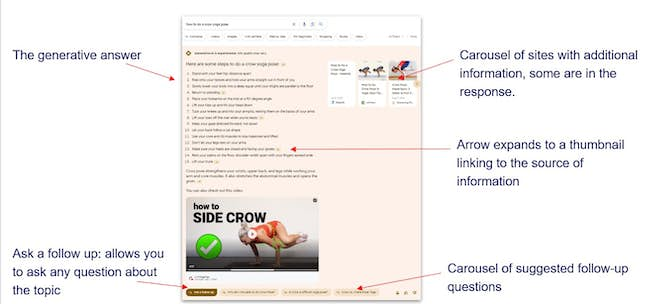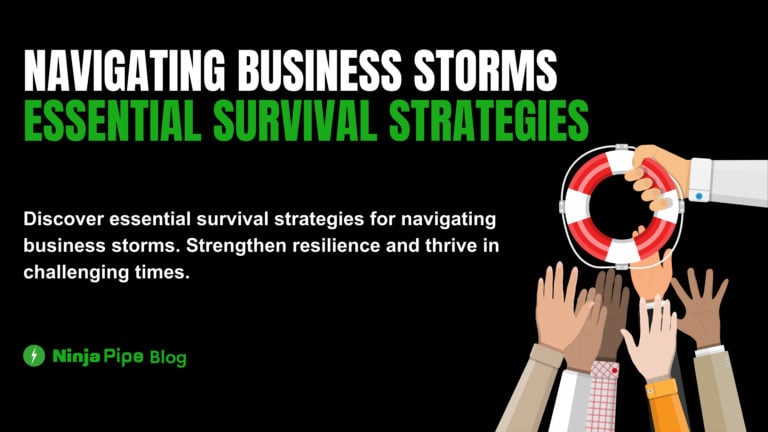Get ready for the AI search era with Google’s SGE. Elevate your digital strategy for advanced search experiences.
Introduction:
The landscape of search marketing is poised for a seismic shift, courtesy of advancements in generative AI. Google’s innovative Search Generative Experience (SGE), though still in its experimental phase, promises to revolutionize conventional notions of search and, consequently, the broader domain of digital marketing.
Just a few years ago, Google’s co-founder Larry Page envisioned the ultimate search engine powered by artificial intelligence, one that could comprehend the entirety of the web and deliver precisely what users sought. While we’re not there yet, we’re making incremental strides towards this vision.
Artificial intelligence would be the ultimate version of Google. The ultimate search engine that would understand everything on the Web. It would understand exactly what you wanted, and it would give you the right thing. We’re nowhere near doing that now. However, we can get incrementally closer to that, and that is basically what we work on.
Larry Page, co-founder of Google
In this article, we’ll delve into the world of SGE to understand its current functionality and explore how it’s transforming the search landscape. We’ll also discuss its limitations, potential impacts, and offer tips on how to prepare your digital strategy for the age of SGE.
What is SGE?
On May 10th, 2023, Google unveiled SGE, a groundbreaking visual transformation of its search engine results page (SERP). SGE leverages advanced AI to generate detailed search results that aim to provide users with precisely what they’re looking for, and more. It’s like an evolved version of featured snippets, taking user interactions with search engines to new heights.
Note: SGE is currently in beta testing until December 2023 and is accessible in English within the United States, Japan, and India. The full-scale launch date remains undisclosed.
SGE in Practice
So, is SGE set to replace the traditional SERP? Not exactly. The SERP will still exist, but it will become significantly more detailed. Think of SGE as an interactive conversation with your search engine, where you can pose detailed, conversational questions, and it responds with AI-generated comprehensive answers.
In practical terms, this means you can input lengthy, conversational queries, and SGE will provide extensive results, along with links for further research. Over time, as SGE better comprehends user intent and web content, its responses will become more comprehensive than ever.
What Does SGE Look Like?
When you enter a query into SGE, the response comprises several key elements:
- Generative Answer: This is the AI-generated answer to your query, presented in a narrative format rather than a list of websites. It’s akin to a conversation with the search engine.
- Dropdown Arrows: These appear alongside the generated text, allowing users to access the sources of the information for validation.
- Website Carousel: A carousel of images featuring links to websites that offer more information on your query.
- Follow-Up Questions: Users can pose follow-up questions to delve deeper into their query.
- Follow-Up Suggestions: If users are unsure about follow-up questions, SGE provides a carousel of suggestions.

Types of SGE Queries
SGE caters to various types of queries, each with its unique characteristics:
- Informational Queries: These involve users seeking factual information, often in the form of questions or general searches. SGE returns detailed responses, often rendering further website visits unnecessary.

2. Commercial Queries: These queries pertain to purchase intent, such as “Best dry dog food for an eight-year-old Labrador retriever.” Paid ads related to the query appear above the AI-generated answers, followed by detailed text answers, links, and popular options.

3. Branded Commercial Queries: Queries that include specific brands, like “Nike running shoes,” generate AI-generated text answers, links to buy the products from various sources, including the brand’s website and third-party sellers.

4. Local Queries: These are location-specific queries, like “dog boarding Wichita, KS.” SGE provides information about local services, along with review snippets, links to review sites, and even a map displaying business locations.

5. YMYL Queries (Your Money or Your Life): YMYL queries typically revolve around lifestyle topics that can impact health or finances, such as “home remedy to treat poison ivy rash.” SGE handles these queries with caution, adding disclaimers to encourage users to seek professional advice.

Limitations of SGE
While SGE displays considerable promise, it’s essential to acknowledge its limitations:
- Inaccuracies: SGE results may occasionally contain inaccuracies or “hallucinations” as generative AI is still evolving.
- Data Voids: SGE might not return results for some queries, either due to a lack of understanding or insufficient quality information.
- Contradictions: SGE results may differ from traditional Google search results, potentially causing discrepancies.
- SEO Data: The extent of data displayed in Google Search Console and how SGE selects thumbnails and text links remain unclear.
We’ve built in strong protections to mitigate against inaccuracies, but like all LLM-based experiences, generative AI in Search is experimental and can make mistakes… It is trained to corroborate responses with resources from the open web, but sometimes responses may reflect inaccuracies that exist on the web at large. We’ve launched this as an experiment in Search Labs to start, and we’ll continue to improve and fine-tune the experience.
Google
Anticipated Impacts of SGE
SGE is poised to reshape paid search and SEO, resulting in several key impacts:
- Pushing Down Organic Results: SGE’s prominent AI-generated text occupies prime SERP real estate, potentially reducing SEO traffic.
- Reduced Website Visits: Comprehensive SGE responses might deter users from exploring websites further, leading to potentially more qualified SEO traffic.
- Continued Display of Paid Ads: Paid ads will likely continue to appear at the top of the SERP, above AI-generated text and organic results.
- Increased Competition: Competition for top positions in information results will intensify, raising ranking difficulty.
- Shift Towards Long-Tail Keywords: Natural language queries will become more prevalent, demanding optimization for detailed, long-tail keywords.
- Emphasis on Customer Reviews: SGE could promote user-generated content (UGC) on SERPs, including customer reviews.
- Metadata Matters: Metadata, including title tags and meta descriptions, remains crucial for enticing users to click on links.
Preparing Your Site for SGE
In light of these impacts, here are some strategies to prepare your website for the SGE era:
- Content Clusters: Develop content clusters around relevant topics to enhance your authority in specific domains.
- Customer Reviews: Encourage and gather customer reviews to boost your online reputation.
- Schema Markup: Ensure your schema markup is up to date to provide structured information that SGE can understand.
- Engaging Content: Craft thorough, engaging content that addresses user queries comprehensively.
- AI-Friendly Formats: Adapt your content to formats that align with AI’s understanding and delivery capabilities.
As we embrace the transformative potential of AI in digital marketing, preparing your digital strategy for SGE’s advent will be instrumental in staying ahead in the ever-evolving digital landscape.
Conclusion:
The emergence of Google’s Search Generative Experience represents a profound shift in the way users interact with search engines. While SGE brings immense potential, it also presents unique challenges and considerations for digital marketers. By adopting forward-thinking strategies and optimizing content, businesses can navigate this new era of AI search and thrive in the evolving digital ecosystem.








Leave a Comment